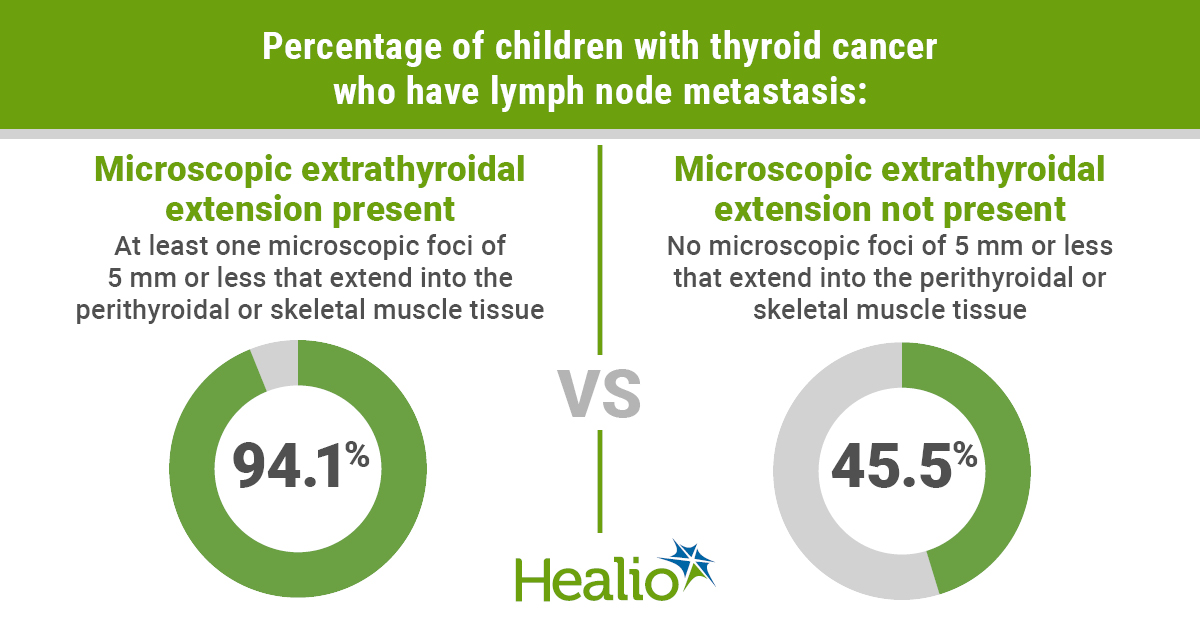Pediatric thyroid tumor evaluation should include microscopic extrathyroidal extension
Children with differentiated thyroid cancer may be more likely to develop lymph node metastasis when microscopic extrathyroidal extension, or microETE, is present, according to findings published in Thyroid.

“The current pediatric version of the [American Thyroid Association] guidelines does not use the presence or absence of microETE to stratify the risk of persistent postsurgical disease, yet, recent data suggest a correlation between microETE and an increased risk of regional [lymph node] metastasis,” Andrew J. Bauer, MD, medical director of the Pediatric Thyroid Center at Children’s Hospital of Philadelphia, and colleagues wrote. “Confirming whether microETE predicts invasive behavior is important to stratifying the risk of persistent, postsurgical disease.”
Bauer and colleagues conducted a retrospective chart review using data from 45 children with differentiated thyroid cancer (median age, 15.3 years; 82% girls). Diagnoses were made from January 2009 to June 2017 at the Children’s Hospital of Philadelphia, and participants were followed until May 2018, with the researchers examining pathology reports to assess characteristics such as tumor size, ETE and regional lymph node metastasis.
All participants had T3 tumors based on the seventh edition of the American Joint Committee on Cancer/tumor node metastasis (AJCC TNM), which has since been updated and no longer includes microETE as part of its T3 designation criteria.

According to the researchers, at least one microscopic foci of 5 mm or less that extended into the perithyroidal or skeletal muscle tissue was used to confirm microETE. This was identified in 34 of the study participants. When contrasted against those without microETE, more participants with microETE had regional lymph node metastasis (94.1% vs. 45.5%; P = .001). In addition, lateral neck lymph node metastasis was observed in 21 participants with microETE (61.8%) and one participant without microETE (9.1%; P = .004).
Bilateral tumors were present in 23 participants with microETE (69.7%) and one participant without microETE (9.1%; P = .001). Multifocal tumors were observed in 24 of the participants with microETE (70.6%) and in two of the participants without microETE (18.2%; P = .003).
“Taken together, our results ... support the recommendation ... that the presence of ETE should be included in the ATA pediatric risk-stratification as a predictor of persistent postoperative disease,” the researchers wrote. “With the elimination of microETE from the 8th edition of the AJCC TNM, pediatric thyroidologists must ensure that ETE is reported in the synoptic portion of the anatomic pathology report with increased attention to ensure its consideration during postoperative decision-making.”
The researchers also found a median tumor size of 2.5 cm for those with microETE and a median tumor size of 5 cm for those without (P = .002), although they noted that there was “considerable overlap in tumor size between these two groups.”
“Larger size was not associated with microETE, and, in fact, tumors with microETE had an overall smaller size compared to tumors without microETE,” the researchers wrote. “The overlap in size between the comparative groups suggests that size may not be a reliable clinical feature to predict microETE or the risk of occult central neck [lymph node] metastasis.” – by Phil Neuffer
Disclosures: The authors report no relevant financial disclosures.
